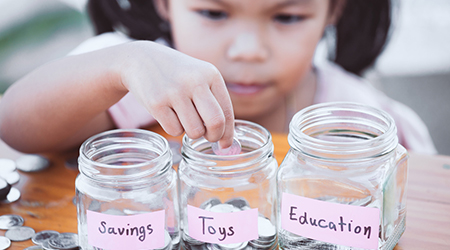This National Teach Children to Save Day, let SafeAmerica Credit Union help you teach financial literacy concepts to children and young adults.
Practical money management skills learned at an early age can have a lasting impact on the rest of your child’s life. In fact, this is one of the most important areas where you can truly change the course of their life. Educating your children about financial wellness will help them build healthy spending habits for the future.
Here are some fun ways to teach your kids about money.
1. Play Games That Involve Money
One of the best ways to teach a lesson is by doing so without your child even realizing they are learning. Play games that include a financial component like Monopoly or Life and help your child strategize during the game. This will help your child learn the importance of budgeting and planning for the future, all under the guise of play.

2. Make A Wish List With Your Child
An important part of financial literacy is creating a set of priorities. We can’t have everything we want all at once, but if we plan ahead, we can hit our goals over time. This is a lesson that children can learn. Sit down with your child and have them list 10 things they want. Then have them rank them from most important to least important. Once the list is created, strategize with your child about how they can achieve their wishes.
3. Teach While You Shop
Take your child shopping and actively explain your decision-making process. When you arrive at the store, tell your child how much money you have to spend and what your priorities are. Show your child why you are picking one item over another and explain things like discounts and coupons. Additionally, give your child small amounts of money to spend themselves. You’ll be surprised at how happy your child will be to spend $2 on anything they want! They’ll also learn the importance of spending with a limited budget.

4. Link Allowance To Chores
To teach your child that money is earned through work, make sure the connection between allowance and chores is clear. You can do this by only giving your child an allowance after his or her chores are completed. When your child does an exceptional job, you can even pay them a bonus as a reward for good performance. This will instill the lesson that you have to earn money—it isn’t owed to you.
5. Split Money Into Categories
Get a piggy bank that splits money into spending, saving, and giving. Teach your child about what each section represents and how they are permitted to use the money in each section. Every time you give them their allowance, talk them through how they plan to allocate their funds. Place the piggy bank next to your child’s wish list, so that their spending and saving goals are clear to them. Also, talk through the causes your child thinks are important, and when they hit a giving goal, donate the money to that cause in your child’s name.

In short, teaching children about finances can be easier than it might seem. It just takes a bit of forethought, a little patience, and some creativity. Once your child learns the basics of finances, you can increase their financial responsibilities by upping their allowance or bringing them into the conversation about family financial matters.
And remember, a financially literate child grows into a financially responsible adult!
SafeAmerica Credit Union offers a Youth Program designed to help your young ones get a jump start on the road to financial success! Choose from savings accounts, starter checking accounts, a youth share certificate and more!

